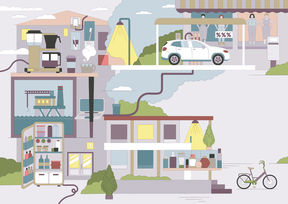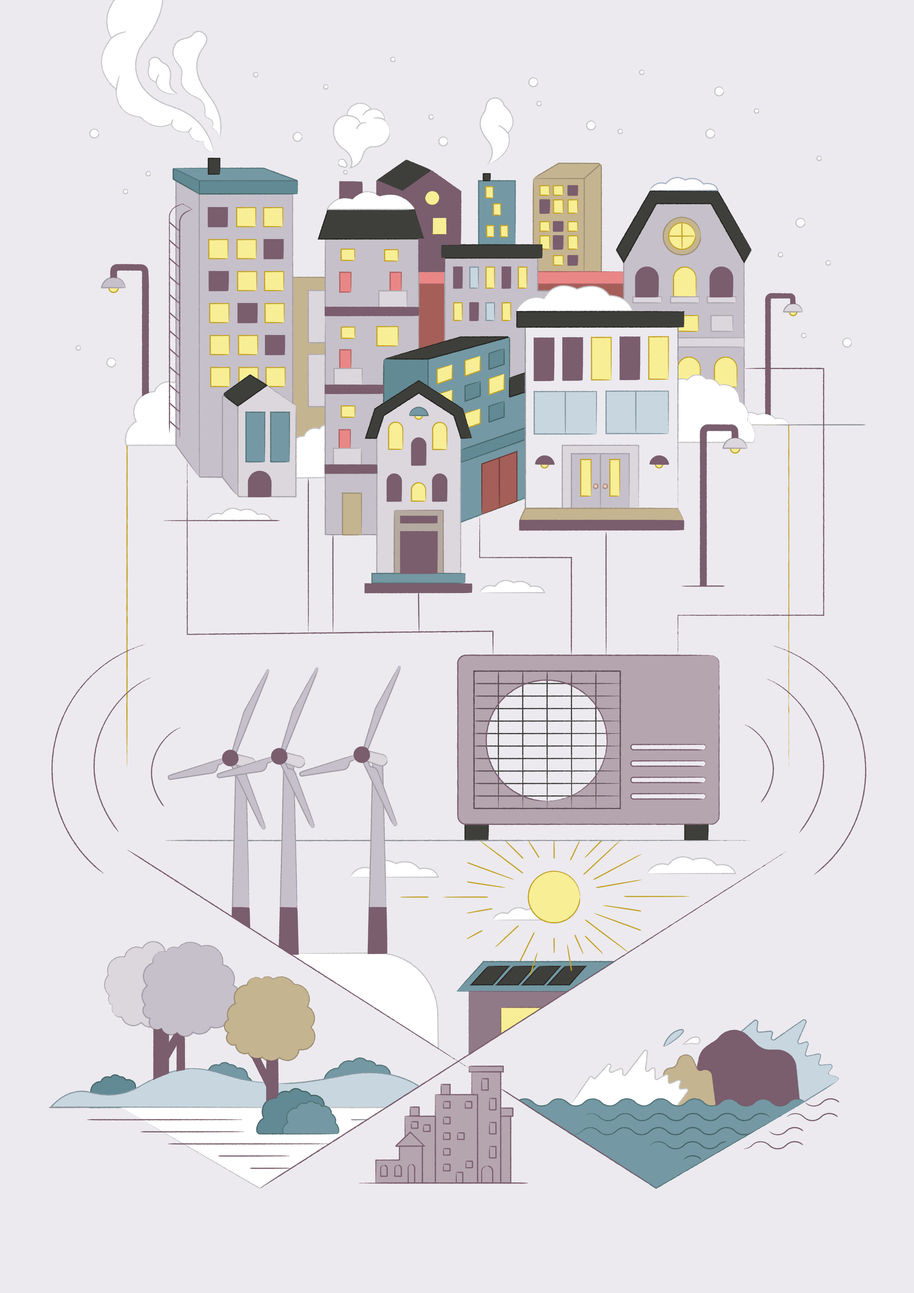Farewell, oil!

They heat our homes, power the coffee maker and keep the factories that make our clothes running. They serve as raw material for our yoghurt cups, transport us to work and bring food to the shops. Fossil fuels – oil, coal and natural gas – are with us in every area of our lives.
Coal, a densely packed fossil fuel, is an excellent energy carrier. The downside is that its combustion crates carbon dioxide, which has the impact of heating the climate. And alongside our fossil fuel combustion we’re puffing up carbon, which had been bound into the ground over hundreds of millions of years, into the atmosphere.
The ecological crisis forces us to ask if we can manage without this fateful partner now that it is exceeding our planet’s ability to cope.
‘Of course we’ll manage. Different sectors are becoming fossil-free at different paces: first electricity, then heat and finally transport,’ reckons Aalto University Assistant Professor Annukka Santasalo-Aarnio. She researches energy storage and conversion, i.e. the processes of converting energy from one form into another.
‘But we will have to revolutionise how we produce and consume energy.’
Fossil-free Finland to lean on wind power
In Finland, more than 40% of the energy used for electricity, heat, transport and industry is generated with fossil fuels and peat. It’s clear that severing this bond will not be simple.
The global energy transition has nevertheless commenced and Finland could bring it to a victorious conclusion, the Smart Energy Transition research project proposes. A multidisciplinary group of researchers has modelled a fossil-free Finland in this Aalto-led venture.
There is no single technology, which could alone take the place of fossil fuels. Instead, the totality will consist of streams, says the project head, Professor Armi Temmes from the School of Business.
According to the models created by the project, 95% of Finland’s primary energy could be generated using existing technologies based on wind, solar energy, biomass and nuclear power. In addition, fossil-free fuels will be needed for heavy transports and industry, for example.
The point of departure is that society is electrified with cleanly produced power. For this to happen, wind and solar power capacity would need to increase more than tenfold because it is no longer possible to boost the sustainable utilisation of biomass substantially, Temmes says in reference to the project’s calculations.
In the cold global north, the hungriest consumer of household energy is heating, and district heating schemes are significant users of coal and natural gas. The Smart Energy Transition has modelled how a city the size of Helsinki could be kept warm cleanly.
The model says fossil fuels could largely be replaced by wind and solar powered industrial and property-specific heat pumps that collect heat from ground, water and sources of waste heat like industry and buildings. Backup power would be provided by a biomass-fueled combined heat and power plant.
Electricity and heat will be more closely coupled in the wake of the energy transition, Temmes says.
Decentralise and conquer
Fossil fuels have done lots to ensure that our energy production remains stable, centralised and manageable. Just add more fuel to the fire when electricity and heat are needed.
In a decentralised system that leans on wind and solar power, supply of electricity fluctuates, necessitating methods to even out imbalances in supply and demand.
We already have many efficient energy storage options, such as hydropower, thermal stores and battery technology, and new ones are being developed all the time. But storage is no conjurer’s trick, which could make renewable energy stable by itself, so we’ll also need to regulate the consumption of energy, Annukka Santasalo-Aarnio points out.
This means that, in future, we’ll have to pay more attention to how we consume electricity. This is where technology is charging to the rescue: intelligent electricity grids and building automation will play an important role in balancing supply and demand.
Closely coordinated team play will emerge between energy and construction. Buildings will have their own solar power systems and heat pumps. They’ll regulate their own consumption with, for example, smart heating systems and will store energy in hot water capacitors and geothermal heat wells. Energy-efficient construction will prevent heat loss, Armi Temmes says.
Professor Armi Temmes, Smart Energy Transition research project‘Electricity and heat will be more closely coupled in the wake of the energy transition.’
Greenhouse gases recovered and stored
Our oil-based transport system is in need of a thorough overhaul. Electric cars, mass transit and new transport services will provide alternatives to driving your own petrol or diesel car, but cannot resolve the problem of heavy transport and air travel.
‘It’s unlikely transport can overcome its dependence on fossil-based liquid fuels, as carbon is an unsurpassed energy carrier. It is, however, a different question whether carbon is extracted from fossil fuels or by recycling the carbon dioxide already present in the atmosphere,’ Annukka Santasalo-Aarnio says.
The development of fossil-free transport fuels has taken mammoth leaps forward in recent years. Finland’s Neste now markets renewable diesel and flight kerosene that have up to 90% fewer emissions than traditional fuels and Santasalo-Aarnio’s research team is part of Neste Digifuel project that aims developing renewable petroleum.
‘For now, all new fuels still have to compete with cheap oil.’
Synthetic fuels, which can be manufactured with renewable energy and free of emissions using hydrogen extracted from water and carbon dioxide from air, are considered the next step in transport fuels.
A liquid fuel would be compatible with current engine technology and fuel distribution infrastructure. Synthetic fuels are also a promising electricity storage solution and they could replace oil as a raw material for the chemical industry.
These are being studied by Santasalo-Aarnio’s group, too.
‘Finnish industry is very interested in this topic at the moment. Business Finland is leading an effort to build an industrial ecosystem in which Finnish universities and major corporations are taking part.’
Technology is an aid, not a solution
We sorely and urgently need alternative ways to heat homes, generate clean electricity for coffee makers and transport people and goods from place to place.
Assessing our energy consumption is of equal importance.
‘To begin with, we must reduce unnecessary consumption. Industry and the transports caused by its deliveries are one of the largest energy gluttons,’ says Annukka Santasalo-Aarnio.
But a clean energy system can’t be built with technology alone, it will require a major systemic change, Armi Temmes notes. Changes to the markets, business activity, taxation and subsidy policies as well as business models will be required.
‘For example, we should immediately begin dismantling tax obstacles that hamper the transition to renewable energy,’ says Temmes.
Energy transition already visibly affects the markets. The cost of wind farms, solar panels, batteries, heat pumps and energy-conserving technologies have reduced considerably. New kinds of transport services and intelligent systems to regulate household energy consumption are available.
‘New energy solutions require the cooperation of many sectors of industry and a global scale. On the other hand, they offer enormous business potential,’ Santasalo-Aarnio says.
The energy transition gives everybody an opportunity to bid farewell to fossil fuels.
‘Climate anxiety is associated with a feeling of powerlessness to change things. Your own solar panel or heat pump provides a feeling of control and a concrete way to contribute to the fight against climate change through your own actions,’ Armi Temmes says.
Text: Annamari Tolonen.
This article is published in the Aalto University Magazine issue 25, October 2019.

Read more news

DeployAI Partners Gather for Heart Beat Meeting in Helsinki
The European DeployAI project's partners gathered for the Heart Beat meeting hosted by Aalto University Executive Education in Helsinki.
Get to know us: Associate Professor Maria Sammalkorpi
Sammalkorpi received her doctorate from Helsinki University of Technology 2004. After her defence, she has worked as a researcher at the Universities of Princeton, Yale and Aalto.
Aalto computer scientists in ICML 2024
Computer scientists in ICML 2024